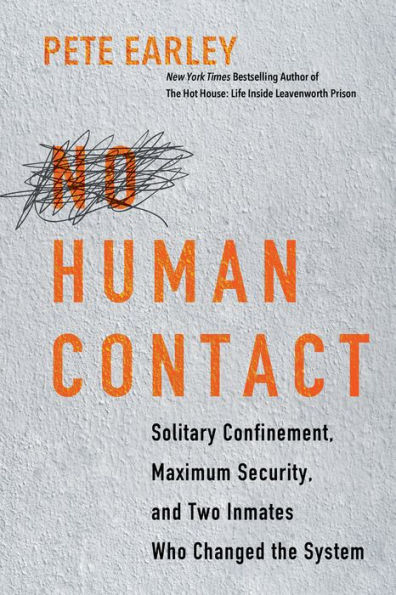No Human Contact: Solitary Confinement, Maximum Security, and Two Inmates Who Changed the System
- By Pete Earley
- Citadel Press
- 304 pp.
- Reviewed by Tom Glenn
- May 25, 2023
A compelling look at an ugly subject.

This is not a book I enjoyed reading — not because it was poorly written, but because of its subject matter. No Human Contact focuses on two men, Thomas Silverstein and Clayton Fountain, both guilty of multiple murders. Silverstein spent 36 years in an isolation cell; Fountain was in solitary confinement for nearly 21 years.
I confess that I am not an unbiased reviewer. When I was a child, my lawyer father spent a good many years in San Quentin after he embezzled $40,000 from a client. (Silverstein also served time there.) The prison sits on Point San Quentin on the north side of San Francisco Bay. I remember it well from the times my mother and I went to visit him.
Both Silverstein and Fountain were involved with the Aryan Brotherhood, a neo-Nazi gang and organized-crime syndicate with an estimated 15,000-20,000 members both inside and outside prison. The Anti-Defamation League calls it the “oldest and most notorious racist prison gang in the United States.” According to the FBI, the Aryan Brotherhood makes up an extremely low percentage of the U.S. prison population but is responsible for a disproportionately large number of prison murders. Silverstein and Fountain were in good company.
Eventually, however, Fountain converted to Catholicism and completed several theology courses during his incarceration. Remotely, he earned an associate’s degree in business and a bachelor’s in philosophy and business from Ohio University. He also earned a Catholic Catechetical Diploma and began a Master of Arts in Religious Studies program from Catholic Distance University. Over time, he forged ties with an order of Trappist monks and was accepted posthumously as a lay brother.
Silverstein, on the other hand, never repented. Before his incarceration, he married a woman named Judy and fathered two children. But he spent the last 42 years of his life behind bars and was convicted of four separate murders (one conviction was later overturned) while serving a sentence for armed robbery.
More of the book is devoted to Silverstein than Fountain, perhaps because author Pete Earley met with the former multiple times in 1986-1987 and corresponded with him for 33 years. It is presumably from that correspondence that the book’s long and detailed quotes from Silverstein originate. Fountain had a similar relationship with the criminologist David Ward, to whom he sent hundreds of pages about himself and hundreds more commenting on the books and articles Ward mailed to him.
So, both men found ways to document their thoughts and reflections. Both had sympathetic correspondents who recorded and sometimes published their words. Silverstein even had his own website. (It’s still up.) The result is that readers are offered valuable insights on prison and its at times inhumane treatment of inmates.
Earley makes no attempt to prettify prison life. He describes matter-of-factly the ways in which the men around Silverstein and Fountain brutalized one another. Castration and rape were commonplace, as were murders. I came away with the feeling that men incarcerated for life but not subject to the death penalty are more inclined to kill than are those with the hope of release. (Turning snitch, which Silverstein and Fountain never did, was a good way for an inmate to get himself killed.)
Silverstein died of congestive heart failure in 2019 at age 67. The New York Times published an 1,800-word obituary, calling him the nation’s “most isolated inmate,” who’d been held in “isolation longer than any other American inmate in a federal prison, more than half his life.” Fountain, by then a fervent Catholic, died of a heart attack in 2004.
So, how bad was solitary confinement? Silverstein described it as “a slow constant peeling of the skin, stripping of the flesh…you hear yourself screaming…want to badly, with all your heart and soul, to leap from your seat, not only to stop ’em but slap the holy shit out of ’em for driving you this insane, where it’s caused you to resort to violence after you could not bear it anymore.”
One facet the author doesn’t report on is America’s exceptionally high incarceration rate — 505 per 100,000 people, the sixth highest in the world — compared to other Western democracies. While the U.S. represents about 4.2 percent of the world’s population, it houses around 20 percent of its prisoners. It’s an excess that we as a country need to address.
A New York Times bestselling author, the prolific Earley writes so smoothly that I barely noticed his individual words at all as I became engrossed in the larger story he was telling. Thus, I can recommend No Human Contact to anyone interested in imprisonment, but I’m not sure how casual readers will react. This is a well-thought-out book on a decidedly unpleasant subject, but it is not intended to be “enjoyed.” If you’re up to the challenge, take it on.
Tom Glenn, Ph.D., is one of our most committed contributors, with well over a hundred reviews to his credit. A retired linguist who worked in seven languages other than English, he now has six books of fiction and 17 short stories in print. You can access his blog, which he updates daily, here.

